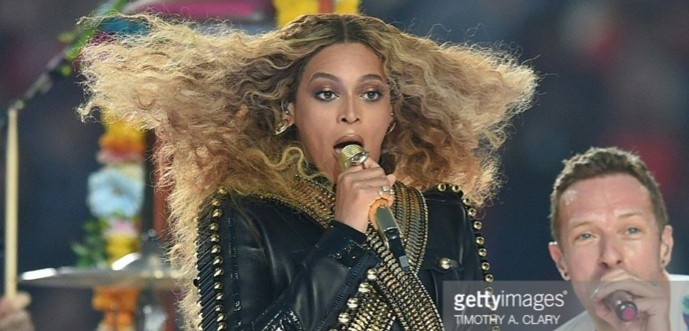“‘You will be ever hearing but never understanding;
you will be ever seeing but never perceiving.
For this people’s heart has become calloused;
they hardly hear with their ears,
and they have closed their eyes.”
-Matthew 13:14-15
After the Super Bowl halftime show, my Facebook news feed consisted largely in Beyoncé’s hips. On their significance emerged two different schools. Both held the hips as irreplaceable1 in their contribution to the success of the show. But while one group saw these hips as merely the vehicle by which Bruno Mars was bested in a female/male dance off, the other saw in those hips liberation. This was, at the least, intriguing.
In case you missed it, during the halftime show ostensibly headlined by Coldplay, Beyoncé performed her song,2 “Formation,” released only on YouTube and the streaming service Tidal3 just 24 hours before.
The video is something to write home about.4 In their reviews, The Guardian, Cosmopolitan, Vulture, Mashable, Vanity Fair, and The New York Times all use the word ‘masterpiece’. Independent of anything else, the video is a triumph of song and spectacle that transfixes. But beyond that, the video is the key to understanding how–in her single minute of Super Bowl solo performance–she can proclaim a message of liberation to those with eyes to see and ears to hear.
Check out the scene in the video that corresponds to the excerpt performed in the halftime show. Bey comes decked out in antebellum-south-swag. She’s dancing in what appears to be a reclaimed Southern plantation that’s been turned black, all the way down to the portraits on the wall. And she sings about what she loves: her husband’s wide nostrils, her daughter’s afro, her ‘Texas bama’ upbringing. These parts of her identity are things that would signal her as a slave, as lacking dignity, as having no domain over her own body. They are what would make her property of the very people she is imitating.
And so she flips the whole thing on its head. Her black identity doesn’t make her a slave. It becomes her source of power and creativity. This (my turn) masterpiece of a song is a celebration of blackness, including (especially!) those parts most despised.5 In her blackness she is proud and at home. There is no one else in control of her body or her voice, as she emphatically lets us know with prolonged, defiant, and obscene gestures.6 She doesn’t need to define herself in terms of what is proper to whites. She is her own master.
For one with eyes to see, the Super Bowl performance is nothing short of a successful slave revolt in the most-watched moment of the most-watched television program of all time. With black and Southern pride, she leads a phalanx (a formation?) of equally world-class dancers dressed as soldiers of black power. They march from the end zone, seize the elevated stage occupied by white-blandness Coldplay and slay.7
And there’s no backlash. Instead of fear or resentment or violence–all too frequent responses to black power–she provokes gratitude. In ‘taking what’s mine’ she ends up the savior of an otherwise uninspired halftime show. Chris Martin’s face radiates relief at relinquishing the reins to Queen B. Black excellence glows on the largest stage of all time.8 Those with eyes to see behold the Spirit come down and, in the words of John the Baptist, proclaim liberty to captives.9
Back to that Facebook news feed. It’s not that those who didn’t pick up on this moment of liberation are racist or hostile or somehow evil. It’s that they missed out. It’s a blessing to be able to see a profound image of liberation in something as profane as a Super Bowl halftime show. It’s a grace any time the power of the Spirit is revealed.
And the very same Spirit that proclaims liberty to captives also brings eyesight to the blind. The Spirit offers this gift of healing to those who couldn’t see this moment of liberation. This new eyesight–a softening of the heart, sharpening of the senses and desire for reconciliation–is what, I think, the Gospel calls us to. Indeed, it’s how Jesus ends his admonition to those with calloused hearts:
Otherwise they might see with their eyes,
hear with their ears,
understand with their hearts
and turn, and I would heal them.’
-Matthew 13:1510
- Sorry, I couldn’t resist. ↩
- Compare this to three years ago, when, in what remains the consensus best halftime show of the modern era, Bey’s setlist featured nine songs from the Billboard hot 100, including five number one singles (!). Seriously, watch it again and enjoy. ↩
- Owned by her husband, Jay-Z, Tidal is devoted to providing higher quality sound and paying artists more than its competitors. ↩
- Apparently, there’s been a lot of commentary on Beyoncé that does does not take as its point of departure a close reading of her hips. That just seems comparatively uninteresting and, more importantly, less fruitful for theological reflection. ↩
- Michael Jackson’s own feelings about his Jackson-5 wide nose, for instance. ↩
- If you somehow missed those gestures, she layers (a particularly Southern) profanity over the top. And African Americans have been lynched for less. ↩
- As it were. Per genius.com, ‘“Slay” is a term first coined within the African-American gay community that has become wildly popular amongst the rest of the nation meaning to “succeed in, conquer or dominate something.”’ Queen B even leverages black queer identity (a yet more marginal intersection) to take power. ↩
- For once, not used in hyperbole. ↩
- Cf. Luke 4:18-19 or “Spirit of the Living God”. ↩
- Cause I can, I’m using the last footnote to thank my Jesuit editors for inviting me to spend the better part of the last two days with Beyoncé and encouraging me to write candidly about race. Because brotherhood. ↩


